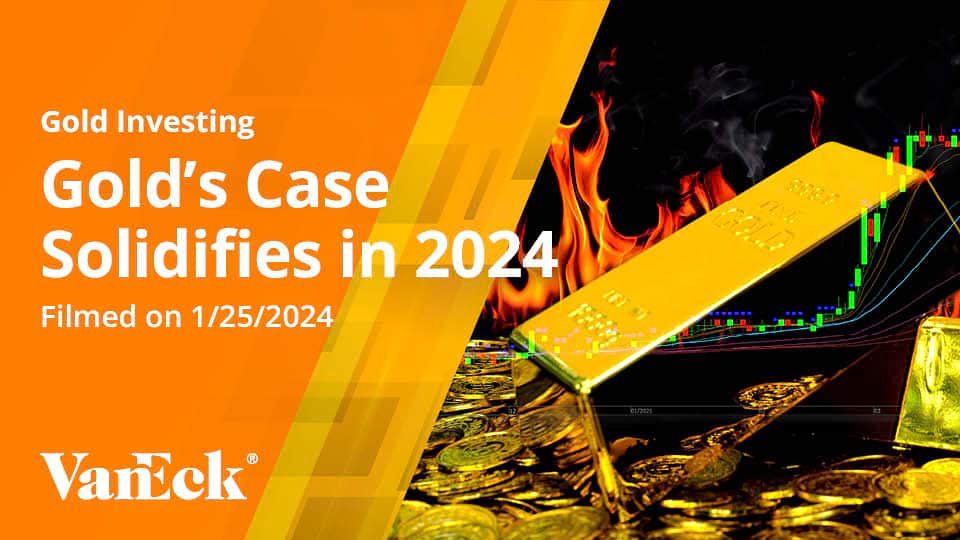Systemic Risks Spark Gold’s Gains
11 May 2020
Read Time 7 MIN
Gold and Gold Stocks Have a Very Strong April
Gold and gold stocks had a strong month, recovering all of their March losses and moving to long-term highs. As the pandemic market panic subsides, investors are trying to gauge the risks and opportunities in a world that carries a level of uncertainty that only those with memories of the Great Depression and WWII have experienced. Continued strong inflows to bullion exchange traded products along with strong demand for retail coins indicates both institutions and individuals are turning to gold as a store of value and hedge against uncertainty. Gold jumped $40 per ounce on April 9 when the U.S. Federal Reserve (Fed) unveiled an unprecedented $2.3 trillion program to aid local governments and small- and mid-sized businesses. It went on to a new seven-year high of $1,747 per ounce on April 14, then consolidated its gains around the $1,700 level. Gold ended the month at $1,686 per ounce for a $109 (6.9%) gain.
Many Large Gold Miners Buck the Trend of Disappearing Dividends
A recent Wall Street Journal article states: “More companies have suspended or canceled their dividends so far this year than in the previous ten years combined”. In contrast, in the midst of a colossal crisis, Yamana Gold increased its dividend 25%, Newmont 79%, and Kirkland Lake 100%.* All three companies have temporarily suspended production at some of their mines due to the lockdowns. These companies exemplify the financial strength and earnings power of the gold industry. For April, the NYSE Arca Gold Miners Net Total Return Index (GDMNTR)1 gained 38.64%, breaking out to seven-year highs. While most industries are struggling, the gold industry is thriving while dealing with COVID-19 protocols and suspended operations. On April 13, BofA Global Research estimated 11% of global gold output had been idled. Since then, Mexico issued partial closure orders, while Quebec, Argentina, New Zealand, and South Africa have allowed gold miners to go back to work. We expect most remaining gold mine lockdowns to be lifted in May.
Four Drivers of the Secular Shift
Gold carries no counterparty risk, its supply is limited, it fits in small places, exists outside of the mainstream financial system, and is universally seen as a store of value. These attributes make it a unique safe haven investment. Likewise, gold companies hold vast resources of gold locked in the ground that only they have the technology and skills to extract and bring to market. While gold and gold stocks are highly tradeable, volumes are dwarfed by stock, bond and currency markets. A relatively small shift in global asset allocations can drive the gold markets. We believe such a secular shift has begun, driven by four broad categories of systemic risk - Deflation, Debt, Inflation, and Loss of Confidence:
1. Deflation
The COVID-19 pandemic is a deflationary shock of the highest order, where demand for almost everything has collapsed virtually overnight. As world gross domestic product (GDP) has fallen sharply, it seems that in the best of outcomes, this will be an average recession. Gluskin Sheff2 calculates the average post WWll duration from the peak of the S&P 5003 to the trough of the subsequent recession has averaged 13.6 months, while the S&P 500 fell 29.0% on average. Therefore, if this is to be an average recession, it would not trough until April 2021. However, a myriad of factors make it easy to imagine a recession with deflationary pressures that lasts longer than average. Here are just a few of our concerns:
- Most people in democracies have never experienced state-controlled lockdowns in which fellow citizens are looked upon with suspicion. Many are horrified by the 24/7 COVID-19 media coverage. As a result, once lock-downs are lifted, investment and consumptions patterns might become more cautious and conservative, at least until a vaccine is widely available and perhaps much longer. Meanwhile, a resurgent virus and more lockdowns are a possibility.
- A Wall Street Journal survey found economists expect U.S. unemployment to be at 10% in December, which suggests a lingering deep recession.
- The International Monetary Fund (IMF) figures global GDP will contract 3% this year, compared to a 0.1% contraction amid the global financial crisis. The IMF sees growth in 2021, but warns that risks of a worse outcome predominate as many countries face a multi-layered crisis comprising a health shock, economic disruptions, falling external demand, capital flow reversals, and a collapse in commodity prices.
2. Debt
Debt is always a problem in a deflation, while excessive debt can become a crisis. When it comes to debt, the elephant in the room is corporate debt, while the whale in the room is sovereign debt. Goldman Sachs forecasts the U.S. budget deficit will reach $3.6 trillion this fiscal year and $2.4 trillion in 2021. This is on top of $17.9 trillion of existing debt which is now trending to over 100% of GDP. At this point it is obvious to us that the government may never be able to pay back the money it owes. At zero interest rates, money is free of charge and sovereign debt keeps piling up. The Fed may never be able to raise rates for fear of a ruining rise in debt service costs. Anyone who owns a business or runs a household knows intuitively that this is not sustainable. Nonetheless, no one knows whether it can persist, end in failure, or whether government debt eventually gets pared down in a cycle of inflation.
According to Rosenberg Research, the volume of business debt has roughly doubled this cycle to over $10 trillion in the U.S. Many businesses are now taking on more debt to deal with the lockdown collapse in revenues through bond offerings, revolving credit lines, and new government lending programs. All corners of the private debt markets are under acute pressure:
- As of April 24, S&P Global Ratings issued 125 corporate upgrades and 1,270 downgrades this year and figures the total for selective defaults could top the $340 billion level of the financial crisis.
- Private pensions have nearly $1 trillion of corporate bonds in their portfolio, while some state and local pensions are effectively insolvent at this point.
- According to the U.S. Chamber of Commerce, over 40% of the nation’s small businesses could close permanently in the next six months.
- Bloomberg News reports home lenders bracing for up to 15 million mortgage defaults in the biggest wave of delinquencies in history.
3. Inflation
We believe the economy will be mired in deflationary pressure for the foreseeable future. The central banks have been trying unsuccessfully to generate wage and price inflation for years. Instead their policies have brought asset price inflation – bubbles in stocks, bonds, real estate, etc. However, if economic growth ever returns to historic norms, complacency towards inflation coupled with the massive pandemic stimulus could bring high levels of wage and price inflation along with asset bubbles.
The world is on a war-footing to fight the pandemic. Past wars have brought double-digit inflation in the U.S. The end of WWI also coincided with the Spanish Flu pandemic:
| War | End of War | Peak Inflation/Year |
| WWI | 1918 | 24% / 1920 |
| WWII | 1945 | 20% / 1947 |
| Vietnam | 1975 | 15% / 1980 |
The COVID-19 war might end with another cycle of unwanted inflation.
4. Loss of Confidence
The government took on unconventional fiscal and monetary policies after the Financial Crisis with trillion-dollar deficits, quantitative easing (QE), and zero interest rates. It tried to scale these extraordinary measures back during the expansion, but failed. Now with unlimited QE, rescue programs to all corners of the debt market, and multi-trillion dollar deficits, fiscal and monetary policies have transformed from unconventional to dangerous. We acknowledge that a massive response to the lockdowns has been necessary, but piling onto an edifice of record peace-time deficits and central bank balance sheets creates a very unstable financial system.
After WWll, the Bretton Woods Agreement created a global monetary order in which dollars were convertible to gold by foreign governments. The Bretton Woods system ended in 1971 as the U.S. was spending heavily on social programs and the Vietnam War. Some countries lost confidence in the U.S. dollar, demanding more gold that the U.S. was willing to provide. Thus, the gold window was closed and the current system of fiat currencies and floating exchange rates was adopted. The fiat currency system is now being trashed by rampant QE and government borrowing. We believe the Fed could be on the verge of issuing money directly to the Treasury to fund spending and debt payment. Call it monetization, helicopter money, or modern monetary theory, no financial system has survived such currency devaluation. If investors and foreigners lose confidence in the dollar-based system, it will be time for a new Bretton Woods, a new global monetary order. Gold would be the last currency standing.
----------------------------------------------------------------------
Related Insights
IMPORTANT DEFINITIONS & DISCLOSURES
This material may only be used outside of the United States.
This is not an offer to buy or sell, or a recommendation of any offer to buy or sell any of the securities mentioned herein. Fund holdings will vary. For a complete list of holdings in VanEck Mutual Funds and VanEck ETFs, please visit our website at www.vaneck.com.
The information presented does not involve the rendering of personalized investment, financial, legal, or tax advice. Certain statements contained herein may constitute projections, forecasts and other forward looking statements, which do not reflect actual results. Information provided by third-party sources are believed to be reliable and have not been independently verified for accuracy or completeness and cannot be guaranteed. Any opinions, projections, forecasts, and forward-looking statements presented herein are valid as of the date of this communication and are subject to change without notice. The information herein represents the opinion of the author(s), but not necessarily those of VanEck.
The views contained herein are not to be taken as advice or a recommendation to buy or sell any investment in any jurisdiction, nor is it a commitment from Van Eck Associates Corporation or its subsidiaries to participate in any transactions in any companies mentioned herein. This content is published in the United States. Investors are subject to securities and tax regulations within their applicable jurisdictions that are not addressed herein.
All investing is subject to risk, including the possible loss of the money you invest. As with any investment strategy, there is no guarantee that investment objectives will be met and investors may lose money. Diversification does not ensure a profit or protect against a loss in a declining market. Past performance is no guarantee of future results.

